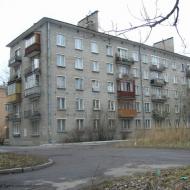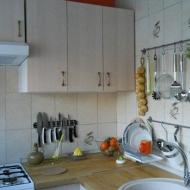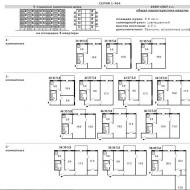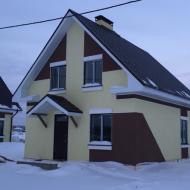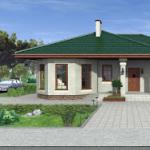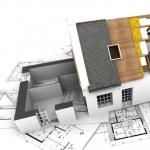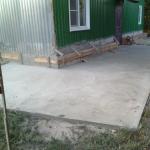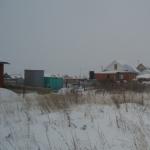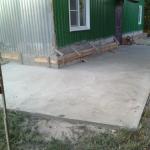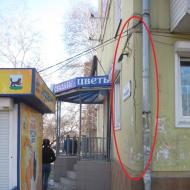
Canadian technology for the construction of a frame house. How to build a house using Canadian technology Advantages of modern Canadian houses
As they say, everything new is a long forgotten old. This statement can be applied to the technology of building houses using Canadian technology. In fact, this method, which has recently attracted the attention of many of our developers, has been used here for a long time. And in Canada, where the name of this technology came from, even longer. The essence of the technology is to create a timber frame house. Moreover, everyone is able to do such a structure with their own hands, the main thing is to figure out what's what, buy material and get to work. This is because the structure is light enough, and you can do all the work with a friend or family member, without hiring special heavy equipment. Every self-respecting man wants to build a house for himself and his family. Let's take a closer look at how to build a house using Canadian technology, what it is, and what stages of construction you need to go through. This information will help you make your dream come true. And by doing most of the work yourself, you can save a lot.
Canadian technology - what a beast

To begin with, I would like to talk about why the construction of such frame houses has come to be called Canadian technology. Indeed, in truth, this method of building low-rise buildings (up to 4 floors) is mostly used in North America, Europe, Australia and even Japan. Why is it called Canadian in Russia? The thing is that it got its name during the cooperation of the State Construction Committee of Russia with the Canadian Mortgage and Housing Corporation. It was then that the rules were created for the construction and design of single-family houses with increased thermal characteristics. These were timber frame houses that we now know. Such structures are in great demand today, since the cost of construction is very profitable.
The reason for the construction of these structures was the fact that it was necessary to keep the warmth in the room. The climate of the Nordic countries dictated the importance of providing a higher heat capacity, which would become an alternative to heating technology. After all, no matter what was used to heat a house, during the heating season, one still had to bear significant heat losses. The promotion of this technology was motivated by the fact that new technological materials appeared on the market, the main properties of which were the preservation of heat inside the room and resistance to low temperatures.

And the last thing that played a decisive role in the application of Canadian technology is the building material used for this. In those regions where there is a great need for such heat-saving buildings, there is more than enough building material. After all, the main material for the construction of such buildings is wood. So it turns out that such houses not only save heat, but are also cheap. To summarize, the whole technology of Canadian house construction is to make the frame of the house out of wood and sheathe it with OSB or SIP panels (OSB panels, inside which there is a heater). Thanks to him, warmth remains in the house, and extraneous noises and sounds do not penetrate into it.
Advantages and disadvantages

The main difference and advantage of this technology is that even without additional equipment in the room, it is easy to maintain and maintain a stable temperature. Despite the fact that living in such a house is quite comfortable in winter. And if you have already made the heating system, then the living conditions are just perfect. As a result, you get an economical home, which requires much less resources to heat than houses made of familiar materials, built using standard technologies.
This is where we come to the second advantage of such a house - its cost and maintenance. Wood is not the most expensive building material. There is enough of it in our area, moreover, it is natural and has a number of positive characteristics. To heat such a wooden house, a powerful boiler is not needed and the amount of resources for heating it is minimal. This will save you money not only on the purchase and installation of a heating system, but also on the use of fuel for heating. After all, the warmth in the premises of a house built using Canadian technology will remain at a stable level and for a long time.

Along with such important positive qualities, the following advantages can also be noted:
- construction speed;
- work can be performed in any season;
- low labor costs and ease of work;
- the ability to construct projects of various complexity, forms and configurations of the building;
- such a structure can be erected on almost any type of soil;
- there is no need to hire professionals and special equipment;
- simplicity and availability of finishing works;
- good sound insulation properties;
- the ability to hide the communication systems under the frame skin, which will contribute to high design performance;
- a feature of all materials used in construction is their ability to retain and retain heat.
But, as you know, nothing can be perfect, and our case is no exception. The disadvantages of Canadian technology can be understood by a teenager as well - if everything is made of wood, then there is a high probability that everything will flash like a match at the slightest opportunity! And indeed it is. And even all kinds of means that make the wood fireproof are not very helpful. Moreover, inside the SIP panels there is insulation, which serves as a bait for various rodents.

Judging by the reviews of those who have already built such a house and live in it, it is not recommended to carry out work in wet weather, so that SIP panels do not accumulate moisture inside.
As you can see, the advantages of this technology are much greater than the disadvantages. And if you decide to build your dream home just like that, you will only be in the black.
What materials does the structure consist of?

As noted, the main difference between such a building is that the entire frame is made of wood. The main materials for him are:
- Wooden beams that act as racks for the frame. Basically, for this, beams are chosen, the cross-section of which is 50 mm and more. Their length depends on the size of the future structure. The most important requirement for this category of material is sufficient strength. And this is no coincidence, since these supports act as load-bearing walls, so they account for most of the load of the entire structure. When choosing a material for these racks, look for hard and durable woods that have greater density and durability.
- Cross beams. They, too, must be made of solid, durable and solid wood. They occupy the second place in terms of the transferred load, therefore, one should not save on material either. The crossbeams must be able to support the weight of the timber panels, window and door openings.
- Wooden cladding panels. They are shields that are firmly connected to each other. Please note that it is for these structural elements that there is a certain requirement regarding the type of wood. It is important that they are made from coniferous wood. It's all about the characteristics and properties of conifers. The wood contains resin, which gives the material increased resistance to moisture, and also prevents the rapid process of decay. SIP panels can serve as a material for walls - an innovative material with which not only walls, but also the floor and roof are sheathed.
- In order to successfully complete the work on the construction of a house using frame technology, you will need planks to make the floors in the house. In rare cases, concrete is the basis for the floor, on top of which parquet or laminate is laid. Among other things, in order to completely complete the construction work, you will need materials for the roof and cladding products - drywall, wallpaper, ceramic tiles, etc.

So, you have learned what is needed to build a house with your own hands. But where to start and how to build your home quickly and correctly? Let's figure it out.
Design and preparatory work

Any construction starts with design, and our case is no different. The first thing you need to do is make a plan or project for your home. It will not be possible to do it yourself without certain skills, since in such a case there are many nuances of its own, on which the strength, durability and safety of the building depend. Therefore, it is better to entrust such work to a qualified architect who will make all the necessary drawings, listening to your desires, and also be able to make an estimate, calculating how much materials you need and how much it will cost. Of course, the price of such a service is rather big, but it's worth it, especially if you want to build a large house with various design features.
When you do not have additional funds for hiring a specialist, you can search for ready-made projects on the Internet. Only now you will have to be content with what you have. And here you need to be extremely careful, since the origin of these or those plans is not clear. For reliability, do not use free resources, protecting yourself from low-quality material. Better still pay and be calm. Remember, a lot depends on the correctness of the project.

After the project is ready, you need to purchase all the necessary materials. Provide a dedicated room or sheltered area where the wood will be properly stored. You need to keep it dry. Now you need to decide on the construction site and prepare it: remove all unnecessary, bring the light to the site, provide it with water supply and prepare all the necessary materials. Once everything is ready, you can start building the foundation of your future home.
The foundation for a frame house
The process of building a frame house using Canadian technology, like all others in principle, begins with the construction of the foundation and floor for the house, which are the base site for the entire structure. It is very important to do everything right, since the reliability of the entire structure depends on the base. Since a house made of wood is not very heavy, you do not have to make a massive foundation. Nevertheless, in order for the structure to be reliably located on the ground and to be stable, the foundation must be made of columnar or tape and provide good waterproofing.
How to make a columnar foundation? You need to buy asbestos pipes to be buried in the ground.

So, the work process is as follows:
- Preparatory work. You need to carry out the minimum calculations, taking into account the type of soil, the depth of freezing and the number of storeys of your house. Then prepare the surface by removing the top fertile layer. Make markings and mark the places where the pillars will be installed. The strength of the foundation depends on the distance between the supports. The recommended distance is 80 or 100 cm.
When you mark out, you need to pay special attention to the areas most susceptible to stress: corners, walls, stoves. - Make holes in the marked places with a diameter of 20 cm and a depth of 100 cm. For convenience, it is better to use a special hand drill. The supports should be immersed 30 cm lower than the ground freezes in your area, keep this in mind. Depending on freezing, the depth may vary.
- The bottom of the wells is rammed and a sand cushion is made. In these holes, you need to insert asbestos pipes, the height of which is about 140 cm.Remember that the supports should protrude no more than 30 cm from the ground.
- Align all pipes strictly according to the level, cover them with earth on the outside and tamp them. Then prepare a concrete mixture and fill the pipes with it by a third. Sink two reinforcement rods into the pipe, which should protrude 20-30 cm. Now it remains to fill everything to the end.
- The final stage will be the installation of the grillage (bottom strapping). After the concrete has dried, lay a layer of roofing material for waterproofing on the posts. You need to put boards on the supports using the spike-to-groove method. The boards are attached to the foundation with anchor bolts. Fix all elements with screws.

Your base is ready, but you still need to make sure that the bottom rail is even. Use a building level. Now you can start building the floor
Floor device in a frame house
To make a base in a frame house, you need to install logs. Therefore, it is necessary to make grooves in the grillage in advance, in the places where they will be installed. Then install the logs in their places, making a kind of crate for the base. You can use either boards or wooden beams, the size of which is 100 × 50 mm or 150 × 50 mm. You can also choose products of other sizes, it all depends on the features of the operation of the room and the level of load. The lags can be fixed with any fasteners: screws, nails, corners, screws or dowels.

To prevent the wooden structure from rotting over time, treat it with a special compound before installing. Thanks to this, your home will last much longer.
On such a base, you can lay SIP panels or plywood, the thickness of which is 20 mm. It is important to screw the plywood or panel well onto each support log so that your floor does not squeak when you walk on it. Please note that this work is best done on a sunny day, when there is no sign of precipitation. Otherwise, the plywood may swell from rain. Even after you have sheathed the entire floor, it is best to cover it with plastic wrap if it is likely to rain.

If you want your floor to be insulated, it is better to sheathe it with SIP panels with insulation inside. This is done very simply: you need to install panels on the prepared logs. The peculiarity of the panels is that they have grooves along the entire perimeter, due to the fact that the insulation in them is not flush. Therefore, they need to be connected using the thorn-in-groove method. To begin with, the outer surface of the slabs must be covered with molten bitumen mastic. After that, each slab is placed in its place along the perimeter of the house. To connect all the elements together, you need to use a timber that will serve as a thorn. It will be the connecting piece between the two plates. Before joining the panels, it is necessary to apply polyurethane foam into the grooves of the panels. On both sides, the connection must be fixed with self-tapping screws. You can complete all the work in a few hours. At the end, along the perimeter, the ends of the panels must be closed with a strapping bar, which will give rigidity to the entire structure. For this, the void is blown out with polyurethane foam and a board of the required width is installed in it. For reliability, it is also fixed with self-tapping screws.

Erection of walls of a frame house
First you need to make sure that the base you made is perfectly flat. After all, all the irregularities will affect the structure of the building as a whole, provoking distortions. Only then can you start building the walls of your house.

As walls, adhering to Canadian technology, it is better to use SIP panels, the installation of which is simple, and the future house will be quite warm. To make such walls, first you need to make the bottom strapping, on which the panels will subsequently be "mounted". The piping is done in accordance with the blueprints for your house. The strapping boards must be fixed around the perimeter and throughout the house so that they repeat the structure of the ceiling walls. Boards should be of such a width that would allow the SIP panel to enter it. After all, the construction of walls will also take place using the thorn in the groove method.

The harness must be attached to the base with self-tapping screws. To measure the correct placement of the harness, use the template from the self-supporting insulated wire panel. After that, for reliability, a hole is made in the harness and base to the foundation and everything is fixed with anchor bolts. It is better to erect walls from the corners of the house. The first panel is leveled and attached to the strapping bar with foam and self-tapping screws. Now seal the joint and install the second panel to form the corner of the building. Connect the panels to each other at the corner using 220 mm self-tapping screws. Now, according to the drawings, continue to erect the structure in the same way as the floor. The slabs are interconnected by means of a bar, which acts as a thorn between the grooves of the slabs. Don't forget about window and doorways. After the frame is ready, the upper grooves of the panels need to be foamed and the strapping board should be placed there.
Now it's time to make a floor that can be made from both ordinary boards and the same SIP panels. If you are building a two or three-story house, then after mounting the floor, continue to build walls according to the same principle as the first floor. And when you are building a one-story house, then it's time to start building a roof.
Construction of the roof of a frame house

As you know, roofs for houses are different:
- single-slope;
- gable;
- domed.
These are not all types. But traditionally in our area they make a gable roof.

The first step is to install a Mauerlat on the ceiling, to which the entire rafter system will be attached. As rafters, you can use boards 50 mm thick and 100 mm wide. To make a crate, take boards with a thickness of 25 mm and a width of 100 mm. The rafters are installed at an angle of 45-50˚. They can be made directly on the ground or directly on the roof, so as not to lift them there.
So, from above, the rafters are connected to each other by an end connection using nails. To give them rigidity, 500-600 mm should be retreated from the upper connection and the crossbar should be nailed in order to obtain the rafters in the shape of the letter "A". The lower ends must be laid on the Mauerlat and securely fixed. Do not forget to make a release of 200–250 mm.

First you need to install the outer rafters, in front of the house and in the back. To securely fix them and give rigidity, additionally make jibs and a run in the middle. Now place the rafters in the center of the house and nail the ridge board on top. It remains to install the rest of the rafters. Please note that the rafters must be installed in 500 mm increments. You can sheathe the gables with the same SIP panels.
Now you need to make the crate. You need to fasten the boards to the rafters in 50 mm increments. Do not forget to release 200–250 mm beyond the outer rafters. The lathing boards are fixed with nails, the length of which is 60 mm. After the lathing is done, lay one or two layers of roofing material on it to ensure waterproofing. At the same time, it spreads vertically with an overlap of 100–150 mm. It also needs to be fixed to the crate with small nails with a wide head. To insulate the roof, you can lay a layer of insulation from below, and also protect it with a vapor barrier tape.
Frame houseNow the foundation of your home using Canadian technology is ready. As you can see, making such a house is pretty quick and easy, the main thing is the desire and following the instructions. But this is not the end of the construction of the house, you still have to do a lot. But all this is already according to the standard scheme, which is suitable for the construction of any house. You will have to carry out all communications, install windows, doors, make internal and external cladding, etc. Nevertheless, the main work is done, and you can only be proud of how much you have already done. Such a house, made using Canadian technology, will stand for a long time!

































Due to the speed of construction, country houses based on Canadian technology are widely in demand in the suburban real estate market, especially since they can be simply ordered on a turnkey basis. This construction method is very common in Canada, which gave the houses built using this technology their name. Well, since the climatic conditions of Canada are close to domestic ones, the methods of construction of suburban housing developed and tested in this country are relevant for Russian buyers. What can be houses using Canadian technology: projects, prices, photos in our article.

A small frame house built using Canadian technology Source karkas-nsk.ru
Canadian houses: a little history
The first frame buildings were known in Europe during the early Middle Ages. In those days, the structure was based on a system of posts and beams with diagonal braces. The space between the parts of this frame structure was filled with stone, bricks or clay.
Colonists who came to Canada and the United States from Europe used this technology, which allows them to create houses at any time of the year in a short time. To protect against the harsh weather conditions of Canada, the walls of houses were sheathed with boards from the outside and inside, and the voids were filled with any material available. The most commonly used mixture of clay, straw, sand and stone.

Houses in old European cities "distant ancestors" of modern frame technology Source nkkconsult.ru
Thus, the basis for the creation of houses using Canadian technology already in those days was the prototype of insulated panels, with the help of which it was possible to build a high-quality warm house in the shortest possible time. The modern technology of "Canadian houses", adapted for harsh climatic conditions, has a number of advantages and disadvantages.
Benefits of Modern Canadian Homes
A frame house using this technology is erected from panels sheathed with OSB (a material created from wood chips impregnated with polymer resins) and insulated with expanded polystyrene. The dimensions of the panels are selected individually, taking into account the dimensions of the finished building. Insulated panels are ready-made wall elements that are reinforced on a pre-erected foundation. After that, the installation of ceilings, roofs, as well as doors and windows takes place.
- The main advantage of the technology is the speed and ease of building a house. Installation work does not require the involvement of specialized equipment and a large team of builders; on average, a house is erected within 2-3 months.
- A frame structure using Canadian technology will cost about half the price of a full-fledged brick house, while the functional characteristics of both buildings are similar.

Facing brick in the design of a frame house Source karkasblog.ru
- Lightweight panels do not require the construction of a strong foundation, therefore they can be built on sites with any relief.
- Expanded polystyrene filling the space between the panels has high insulating properties. Therefore, the finished building does not need additional sound insulation and insulation.
- Wooden panels at the base of the frame create a pleasant atmosphere in the home.
- The lightweight material of the walls allows you to choose various methods of external finishing of the finished building: decorative bricks, plaster, boards - all this is available for owners of frame houses built using Canadian technology.
- Thanks to custom-made panels, the finished structure can have almost any architectural form.
Unlike dwellings created from beams or logs, Canadian wooden houses allow the installation of utilities inside the panels themselves. Thus, finished living spaces look more aesthetically pleasing, and less time and effort is spent on installation.
Video description
More about the advantages of Canadian houses in the video:
Disadvantages of building a house using Canadian technology
Despite the many obvious advantages, houses using Canadian technology have a number of features and limitations, thanks to which they are not suitable for all owners of suburban areas. The main feature of the technology is the limitations on the dimensions of the finished building. The height of each floor should not exceed 3 meters, there can be a maximum of 3.

The compactness of Canadian homes does not affect their functionality and pleasant appearance. Source avantage-dom.ru
The environmental friendliness of the finished building can raise questions due to the abundance of polymer resins that impregnate the product. However, this is a question of the integrity of the manufacturers of such structures - if the panels are made in compliance with the technology, then they comply with all environmental safety standards.
The characteristics of the finished residential building, in addition to the quality of the material, are also determined by the professionalism of the team of workers. If the conscientiousness of the contractor is combined with high-quality components and finishing in accordance with all the rules, then a Canadian house is a comfortable and durable home.
Features of the constituent frame houses
Regardless of the technology chosen, the construction of a house using Canadian technology will be carried out in several stages. When choosing a material for each of the elements, it is necessary to take into account its functional characteristics.
Foundation
A common option for the construction of frame structures is a strip foundation, which is a concrete structure immersed in the ground by about 50 cm, the height above the ground is 20-30 cm. With correct calculations, a strip foundation allows you to erect a residential building on various types of soil, including swampy and mobile. The main disadvantage of such a foundation is the impossibility over time to make a global redevelopment of the house.

Ready strip-and-column foundation "in section" Source emupauto.ru
Screw foundations can be immersed to a considerable depth, which makes it possible to use them to create a foundation for a house on difficult soils. The main disadvantage is that a noticeable shrinkage of the structure is likely, especially with errors in calculations or violation of technology. As a result, after the completion of construction work, you will have to wait some time with finishing. In addition, there is no need to think about the basement or the basement in such a house.

Screw foundation made of metal piles Source 72.ru
The most reliable option is a slab foundation, which is a flat reinforced concrete "pillow" on which the structure is being erected. Due to its high cost, it is usually not used when building prefabricated houses using Canadian technology, but on sandstone or with an abundance of groundwater, this may be the only possible option.

Schematic diagram of creating a slab foundation Source profundamenti.ru
Most often, the cost of the foundation is calculated separately from other work on the construction of a frame house. Experienced specialists will help the customer choose the optimal type of foundation, depending on the characteristics of the building and the surface on which it will be erected.
Floor covering
At the heart of the future floor are floors made of wooden beams, which are placed on the foundation of the house. Most often, slabs made to order together with materials for the walls of the house are used for covering on the ground floor. Installation of this part of the house is carried out immediately after preparation of the foundation, the joints of the plates are carefully processed with a sealant. The next layer is insulation and vapor barrier materials. After that, a finishing coating, for example, laminate, is placed on the finished "rough" floor.

Subfloor with insulation, prepared for fine finishing Source indigostroy.com
The floor on the second and third floors is erected in the same way, while the amount of used insulation and vapor barrier material is less than that for covering the first floor. Soundproofing materials come to the fore here, which ensure a comfortable living.
The construction on the second floor is based on the floors, on which the subfloor is located, insulation materials, slabs and finishing (for example, linoleum).
Material for the walls of the house
Regardless of the architectural project, Canadian frame houses are based on SIP panels, which are particle boards with a layer of insulation. As a rule, such elements are installed without an additional frame, but at the request of the customer, the house can be additionally strengthened.

The appearance of high-quality SIP panels in stock Source sipanel174.ru
If necessary, thermal insulation boards made of mineral wool are added between the frame elements.
Outside, the walls are covered with a film to protect against moisture and wind penetration.
The construction of houses using Canadian technology involves the use of various facing materials: siding, facade panels made of composite materials, porcelain stoneware and stone tiles, plaster or wooden boards. At the same time, depending on the option chosen, the facing materials will be attached to the wall surface in different ways.

Modern materials help to create any exterior finish Source mastersmi.com
Regardless of the type of finish chosen, consideration must be given to ventilation gaps, which help free air circulation and prevent moisture build-up. Thus, the final wall thickness is made up of the panel, interior and exterior finishes, and the technological gap.
Roof of a canadian house
The chosen shape and materials for the roof of the house entirely depend on the amount of precipitation, climate, and also the intensity of the winds.
The main material for the roof is SIP panels placed on wooden rafters (strong beams that form the slopes of the future roof). If necessary, additional thermal insulation is attached to the panel.
After that, the roofing material is selected. The most common option is a metal profile - sheets of various shapes that protect the roof from external influences. For the comfort of residents, such material must be equipped with sound insulation so that the noise of the rain is heard less.
An alternative option is soft bituminous shingles, which are lighter and easier to install.
The choice of roof shape is limited by the average rainfall and the customer's taste preferences. For example, budget houses most often have a standard gable roof. It prevents water retention, neutralizing the possibility of leaks, and also allows you to equip a spacious attic space.

Laconic house with a gable roof Source planlook.ru
Multi-slope roofs look more original and allow for complex architectural solutions. The main disadvantage of this option is the complexity, and, as a result, the high cost of installation work.
Book and Film by Larry Hon "The Very Effective Carpenter"
Reliable and easy-to-install SIP panels, which are easy to install without additional construction equipment, allow you to create a home with your own hands.
The book and film of the carpenter Larry Hon "The Very Effective Carpenter" describes in detail the process of erecting a frame house using Canadian technology. Each chapter of the book and a series of the film is devoted to the components of the house: the ceiling, walls, roof, as well as the independent construction of the stairs. At the beginning of the video, it tells about the course of calculations for the required amount of building materials, the necessary tools are mentioned, and the progress of the work itself is shown in detail.
Video description
Larry Hon's film:
The work of the master shows that the construction of a durable building requires not only experience and skill, but also the selection of materials with the necessary technical characteristics. Unfortunately, when creating a house "there are no trifles." For example, an improperly created foundation or a violation of the roof insulation technology leads to premature destruction of the house.

The process of erecting a frame house Source 1asku.ru
Larry Hon's step-by-step video guide complements the book, and also allows you to trace all the nuances of the process of building a house in order to fully appreciate the quality of the construction team's work. This will avoid serious mistakes in construction.
Any projects of Canadian houses and cottages can be built on a turnkey basis. This service is provided by qualified technicians using approved technologies. The progress of construction should be monitored in order to check the quality of the work, but at the same time, it is better to entrust the calculation of materials and the subtleties of the process to professionals.
Video description
The general progress of construction is shown in the video:
Consequences of technological errors during the construction of a building
The main mistake when building a house is inappropriate savings. SIP panels are based on wood, so it is strongly recommended to pay attention to their quality. Wet, improperly dried, or rotten wood means future wall gaps, drafts, and rapid house destruction.
All joints in the finished structure should adjoin each other as tightly as possible, all gaps must be treated with sealant and construction foam. This will avoid unnecessary "cold bridges" (places where rain and wind penetrate), which contribute to the destruction of the house.
 Source www.pinterest.ru
Source www.pinterest.ru
A finished house from SIP panels, treated with a sealant: the seams are tightly adjacent to each other Source tutknow.ru
Tight-fitting panels require the installation of additional ventilation, as well as the use of artificial gaps. Before starting work, you should ask the builders exactly how the ventilation of the house will be carried out.
The quality of the panels themselves, manufactured at the factory, should be checked before installing the building. As a rule, SIP panels, created with high quality, have smooth edges, regular shape and uniform color. It is strongly discouraged to purchase cheap Chinese-made slabs that are not adapted to harsh weather conditions.
Popular projects of Canadian houses
The most common house designs using Canadian technology are one-story, one-story with an attic, standard two-story, as well as houses with a garage.
A traditional one-story house with an extensive porch and a gable roof is the best option for a small family. Plaster and wood paneling, as well as laconic forms create a complete look of the building. The absence of large windows and a glazed veranda will save on heating the building.

One-storey house with a porch and large windows Source blog-potolok.ru
The original architecture of the one-storey building with an attic is created due to the irregular shape of the windows. The gable roof used in the architectural solution prevents moisture accumulation and protects the roof from leaks. The glazed porch is a miniature analogue of a summer veranda.

The porch of a two-story house adjoins the end wall Source seattlehelpers.org
The combination of a small terrace, stone and plaster finishing gives the two-storey house solidity and quality. At the same time, the architectural solution is very compact and budgetary: the gable roof is easy to install, heating costs are minimized due to the open porch and terrace on the second floor.

Solid two-storey house with large windows and a terrace Source ekzo.by
Facing with natural stone and brick is a sure way to give an affordable and laconic home exclusivity and reliability. Small skylights, original decorated pipes and a modest porch give the building a complete look. The organically built-in garage with small windows can be used as an outbuilding.

Two-storey house with an attic and built-in garage Source belarusinfo.by
Video description
Experience shows that there are moments in the construction of a house where it is absolutely not worth saving, but there are nuances where you can not only save, but rationally spend the budget (which is kind of a reasonable economy).
What to choose - price comparison
Houses based on Canadian technology, erected by qualified specialists using high-quality materials, are an excellent option for suburban housing. Ordering a turnkey frame house guarantees that many technical nuances are taken into account, allowing you to create a durable structure. To simplify the choice, prices from developers are presented below for turnkey Canadian houses:
 Source tr.skopelitissa.com Source tr.skopelitissa.com |
 Source dekardkarkas.ru Source dekardkarkas.ru |
 Source dekardkarkas.ru Source dekardkarkas.ru |
| 7.5х8.8 from 5.1 million rubles | 7.5х9.8 from 5.3 million rubles | 8.4х9.9 from 5.9 million rubles |
 Source dekardkarkas.ru Source dekardkarkas.ru |
 Source dekardkarkas.ru Source dekardkarkas.ru |
 Source sk-domostroi.ru Source sk-domostroi.ru |
| 8.65х9.75 from 5.3 million rubles | 8x13 from 6.4 million rubles | 11.8x10 from 7.2 million rubles |
 Source sk-domostroi.ru Source sk-domostroi.ru |
 Source sk-domostroi.ru Source sk-domostroi.ru |
 Source vachdom.ru Source vachdom.ru |
| 6x6 from 2.9 million rubles | 6x8 from 4.2 million rubles | 6x8 from 3.7 million rubles |
 Source www.cottage.ru Source www.cottage.ru |
 Source myfeo.ru Source myfeo.ru |
 Source dom-expert.by Source dom-expert.by |
| 8x8 from 4.1 million rubles | 9.5x10 from 4.9 million rubles | 8x10 from 4.6 million rubles |
In cooperation with us, clients invariably receive a number of additional benefits. In particular, a five-year warranty applies to the entire range of services.
How to build a turnkey frame house using Canadian technology with minimal costs
Currently, there are a lot of modern technologies used in construction. But building turnkey frame houses is still the most profitable. The final cost of the house project is arranged by all clients who do not plan to spend a lot of money, wait for their arrival for a long time. It should be borne in mind that the construction of turnkey frame houses makes it possible, immediately after the construction of the walls and roof, to make a complete finish, since the buildings do not shrink, which means that you do not have to wait for the time of your settlement for several years.
The unique Canadian technology for the construction of frame houses, the price of which is also considered the most affordable of all available options for technological construction, allows you to save money and not give up additional cubic capacity, which will cost several times cheaper than, for example, the same area when building from bricks. We will carry out the installation of the house, taking into account all the norms and requirements that are applied in modern construction. Intel Group specialists have vast experience in the provision of such services. Currently, it is possible to build a turnkey frame house using Canadian technology with additional discounts on the action.
The most affordable price for a turnkey frame house using Canadian technology will allow you to solve the housing issue in a short time, and not postpone it indefinitely. A practical technology for building a turnkey house according to the Canadian system was developed taking into account the peculiarities of the climatic conditions of Russia. A frame house will be warm even in regions with harsh conditions, for example, in the Far North, such structures have proven themselves well even in cold winters.
Millions of owners have already appreciated Canadian houses, who were satisfied with all the conditions of construction, payment, and most importantly, received comfortable, modern, warm and cozy housing. Our prices for the construction of turnkey Canadian frame houses will suit the most demanding client.
Initially, you need to order the foundation for the construction of houses using frame technology according to the selected project. Features of the technology for the construction of prefabricated houses allow making lightweight pile foundations. This, in turn, is a guarantee that all work will be completed in the shortest possible time, the cost of the foundation itself will be 30-50 percent lower than when using traditional technologies.
Accordingly, the price of frame construction of a house is immediately reduced at the zero stage. Only the Canadian technology for the construction of frame houses, the price of which has been reduced, allows significant savings, which is why such options are increasingly chosen by citizens who have long dreamed of their own housing, but for one reason or another did not dare to start construction.
Fast execution of home projects at Intel Group is carried out by highly professional engineers who always take into account the basic requirements of the client. If necessary, you can opt for standard designs. Only we provide services in building a house at the most affordable prices, if we compare the prices of companies in Moscow or other large cities of Russia.
You can find out what is the price for a turnkey Canadian frame house on our website or at the company's office during a personal visit. We will build a house quickly, we will conclude an official cooperation agreement with each client who contacted our company. The catalog contains a large selection of typical designs. This means that we will build a house according to individual drawings or a finished project, which has already been tested and worked out taking into account all the wishes of our clients. The price of the house will suit you completely.
Canadian homes, which are so popular in Canada, the northern states of the United States, and other temperate continental climates, are considered energy efficient, inexpensive, and quick to build. Due to their technological advantages, they can compete with traditional methods of building private housing from brick or aerated concrete.
The main structure of Canadian houses is a wooden frame based on a solid timber. Before the installation of frame houses using Canadian technology, a reinforced concrete driven or pile-screw foundation is installed.
The frame of the Canadian house consists of vertical wooden supports that are 60 cm apart. The distance between the posts is designed in such a way that the house can be easily clad with OSB panels, which strengthen and tie the entire structure. The supporting pillars are connected from above with floor joists 200x50 mm from calibrated beams.
OSB boards are mounted on beams using standard hardware. House insulation is carried out from non-combustible ECO insulation 200mm, using hydro-vapor barrier membranes. Thanks to the processing of wood with a fire-bio-protective composition of deep penetration, the finished structure is reliably protected from fire.
The price of construction of frame houses using Canadian technology is not fixed. You can familiarize yourself with the approximate cost by examining examples of finished projects on the Woodhouse website. For consultation, call the manager or order a call back!
Until recently, frame house building in our country was poorly developed - basically everything was done solely on a whim. Whereas in America and Scandinavia, the technology for the construction of frame houses has come a long way, turning into a set of standard, proven and proven solutions over the years. Among the craftsmen of the portal from Moscow to Vladivostok there are a lot of adherents of frame housing construction, erecting small-sized country houses or new country houses for permanent residence with their own hands or under their control. How many people, so many opinions and skills, therefore there are dozens of variations on the theme, but there are two initial technologies of houses on a wooden frame - Canadian, it is American, and Scandinavian, it is Finnish. These technologies for building houses will be discussed in the material.
- Frame house building;
- Canadian technology for the construction of frame houses;
- Scandinavian house technology.
Frame house building
In frame house building, regardless of the materials used, be it wood, metal or concrete, the main structural element is the supporting frame, and not the walls. Most modern high-rise buildings are erected using monolithic-frame technology, pouring concrete into the reinforcement frame, and filling the walls with masonry materials. In private construction, wooden frames are most common; LSTK (light steel thin-walled structures) or home-made metal frames from a profile are somewhat less common.

The popularity of wood is explained by its availability and ease of processing, and in terms of durability, a properly assembled frame is not inferior to stone buildings, which has been proven by zealous Europeans.
Canadian and Scandinavian technologies are considered benchmarks - adherence to them guarantees a reliable, durable and energy efficient design.
But certain differences are observed.




Frame houses using Canadian technology
On the portal there are many craftsmen who build "Canadian" and "Scandinavian" frame frames for themselves, but there are also professionals who have dozens of buildings on their account. One of them - Roracotta (Vladimir), A Canadian (American) technology forum “guru” who generously shares his expertise on numerous topics. The construction of a frame house using Canadian technology, "Canadian", is as follows.
Roracotta user FORUMHOUSE
In Canada and America, there is only such a construction order:
- Foundation and waterproofing;
- Installation of strapping, floor log and covering it with OSB or plywood;
- Installation of a wall frame (sometimes immediately with cladding);
- Installation of a lag overlap of the ceiling or floor of the next floor;
- Installation of the frame of the walls of the next floor;
- Installation of a rafter system and roof sheathing with OSB or plywood;
- Sheathing of the finished frame with OSB or plywood (if this was not done during the construction of the walls);
- Roofing;
- Installation of external windows and doors;
- Laying of communications and engineering networks;
- Installation of insulation;
- Vapor barrier;
- GKL.
This building technology is characterized not only by the construction of walls on the sub-floor platform, but also by other features:
- assembly of the frame only from dry lumber, all elements from the board, if necessary, double / triple, no timber, both in the corners and in other parts of the structure;
- in the area of openings, double racks;
- the openings are reinforced with a board installed on the edge (header);
- double top harness;
- at key points (corners, abutment of partitions, racks), the overlap of the upper and lower row of the strapping.



The pros advise paying special attention to fasteners.
Roracotta user FORUMHOUSE
A properly assembled frame does not need any metal corners and brackets. Is that for anchoring (fixing) the roof to the walls or separate "T" lag joints. The only thing is that the harness of the house is allowed to be connected with special plates. But I've never seen them used. To attach a 100 mm post, two nails (85 mm) must be driven into the end. For a 150 mm post, three nails per side. For windy regions, special steel strips are added, which are nailed to the rafters, then, without breaking, to the strapping and to the rack itself along, with nails.
For fastening the frame elements, the technology provides for the use of smooth nails. The use of twisted or notched ones will not give greater strength, and it is more difficult to work with them.
As a cladding, OSB with a thickness of 12 mm or more is used almost everywhere. On the roof, if the distance between the rafters is more than 60 cm, thick plywood is laid. Like the frame, the sheathing is fixed with nails (45 mm), a deformation gap (2-4 mm) is left between the sheets. Plates provide the frame with additional rigidity, which makes it possible to do without jibs. Slabs can be mounted on the walls both horizontally and vertically, but horizontally, sprawling, is more practical. On the logs and rafters, the slabs are stacked strictly across.
 Frame house: Canadian technology.
Frame house: Canadian technology.
One of the most important points in the construction of a frame is vapor barrier. In Canada and America, thick, virgin polyethylene of 150-200 microns is preferred over specialized membranes.
Roracotta user FORUMHOUSE
- Polyethylene is fixed with a stapler on racks with a step of 30-40 cm.
- An overlap is required between the sheets (15 cm in both directions);
- The joints are carefully glued with special glue or special adhesive tape that adheres to polyethylene;
- First, the ceiling is insulated, then the walls, but if the joints are properly sealed, it does not matter;
- No vapor barrier is needed between residential floors and adjacent warm rooms;
- In the process of assembling the frame, a strip of polyethylene (50 cm) is vertically packed in the joint between the outer wall and the inner partition, from floor to ceiling. Subsequently, to these polyethylene sides protruding from the frame, common polyethylene is glued along the perimeter of the walls.
 Canadian home decoration system.
Canadian home decoration system.
Mineral wool in all varieties is widely used as the main insulation - it is cheaper than PPS (in Canada), and communication in the walls with such insulation is easier. Styrofoam is used if the walls are too thin and there is not enough cotton wool for the standard resistance to heat loss. It is also combined with cotton wool for insulating floors and for eliminating cold bridges along the racks. Classic wall "pie" of the Canadian frame:
Roracotta user FORUMHOUSE
From the inside to the outside - gypsum board, polyethylene or cellophane on the racks and ceiling, racks with cotton wool, OSB (9-12 mm), a protective membrane, foam for screws or special nails with wide gaskets if the facade is plaster. Everything. Do not listen to anyone and do not invent anything else. This is not a new scheme, it has been tested for decades. All skeletons on the North American continent are built on it.







Scandinavian frame construction technology
Porcupine (Alexey), the founder of the topic on the Scandinavian technology of frame housing construction on the forum, with his light hand she went to the masses, this is how the basis describes.

Porcupine user FORUMHOUSE
The construction technological chain is approximately as follows:
- The base is being made - an insulated slab or strip foundation (insulated floors on the ground);
- External walls and load-bearing partitions, if any, are placed on the ribs;
- Roof trusses are installed;
- The frame is sheathed on the outside, and the roof is made.
It turns out such a huge hangar on the foundation, and without internal non-bearing partitions. After creating the closed circuit of the building, in a calm atmosphere, without wind and rain, the house is being completed. The creation of the foundation slab, underfloor heating and its pouring is completed, new internal partitions are installed, it is insulated, finishing is done, etc.
Scandinavians are characterized by "semi-finished products" - they are built mainly from pre-assembled house kits of varying degrees of readiness - from ready-made modules to a set of ready-made parts (the so-called pre-cut). If we are talking about a frame of individual elements, followed by insulation and sheathing, then again, all the parts are sawn and numbered, the assembly remains in place according to the project.

We most often use this particular system, with the difference that all elements are cut independently. As a heater, Scandinavians also prefer mineral or basalt wool (local); in recent years, cellulose wool (ecowool) has become widespread - especially in floors and in attics.
Like Canadian, Scandinavian technology is demanding on lumber - dry planed board, no timber, only if this is not due to the specifics of the project.
There are several differences between the approaches.

Porcupine user FORUMHOUSE
In fact, the Scandinavian frame is a modernized version of the Canadian, the Scandinavians, due to living in a harsh climate, put energy conservation at the forefront. And double and triple boards (strapping, opening posts), potential cracks and cold bridges, which they decided to avoid. As a result, the angles and jibs in the frames are the same, but:
- single top strapping;
- a crossbar is cut into the posts of each wall along the entire length;
- single racks on openings.



It is the presence of the crossbar that is a characteristic feature of the Scandinavian frame, since it allows you to do without reinforcing the openings and replaces the double top strapping.
A typical wall "pie" looks like this:

From outside to inside:
- facade cladding;
- ventilation gap;
- facade gypsum board, MDVP (soft fiber board) or only wind protection;
- power frame with insulation 200 mm thick;
- vapor barrier (also most often polyethylene 200 microns);
- an additional layer of insulation (horizontal lathing and insulation);
- GKL or other finishing interior material.


